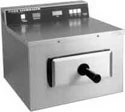|
If you or someone you know is considering getting LASIK EYE SURGERY, then you may be at risk of getting DLK (Diffuse Lamellar Keratitis), which is basically a horribly uncomfortable eye infection. The bacteria that causes DLK grows in water. If your LASIK EYE SURGERY doctor is using a steam sterilizer, then you are AT RISK of getting DLK. This is because steam sterilization requires cleaning and drying of the sterilizer prior to sterilization. There should be no sign of wetness in the reservoir. In the reservoir is where the bacteria that causes DLK grows. However, with Dry Heat Sterilization, there is no water used at all. The sterilization is being done with pure heat. References of doctors who are using dry heat sterilization is available upon request. ELIMATE THE RISK Make sure that your doctor is using a Dry Heat Sterilizer to clean his instruments. this is the only RISK FREE sterilization process that prevents against getting infected with DLK. Print this page and show it to your doctor prior to surgery.
|
|
Some information you need to know before you go for a LASIK surgery. 1. What kind of sterilizer is your doctor using?2. Is your doctor using a steam sterilizer or a Dry Heat Sterilizer?Here is a study that was done in July 2000.Outbreaks of diffuse lamellar keratitis (DLK) associated with laser in situ keratomileusis (LASIK) may be related to endotoxins released from sterilizer reservoir biofilms, suggest findings from an epidemiologic study.Over a four-month period, an epidemic of DLK occurred at the authors’ refractive laser clinic.To determine the cause of the outbreak, the researchers conducted a clinic-based cohort and laboratory study. There were a total of 52 cases of DLK among 980 evaluable patients.The authors isolated Burkholderia pickettii from the sterilizer reservoir. Variation in attack rates was not explained by patient sex or age, operating suite temperature or humidity, drapes used, saline solutions used, microkeratome use or time of day or order of surgical schedule.The authors compared two sterilizers before treatment to reduce biofilm with a third sterilizer after such treatment. For Sterilizer One versus Sterilizer Three, the relative risk was 9.4 (95 percent confidence interval [CI], 7.5-11.8); for Sterilizer Two versus Sterilizer Three, the relative risk was 18.7 (CI, 11-32).There were three cases of DLK after treatment to control biofilm; however, these were sporadic in nature and associated with epithelial defects. “We would encourage any clinics that experience a cluster of DLK to consider microbiologic and epidemiologic investigation for the effectiveness of sterilizer biofilm control,” the authors concluded.“If our findings can be replicated, reservoir biocide cleaning or modification of sterilizers should be possible to reduce the likelihood of biofilm development, thus minimizing DLK occurrence.” (Holland SP, et al. Ophthalmology 2000;107:1227-34.)Testimonials: 1. Dr. Garabeth. Has 13 of the Cox units. Using the Moria MicroKaratone. Thoroughly Tested & Proven TechnologyBiological tests were conducted on the Cox Rapid Heat Transfer Sterilizer by the Microbiology Department at the Baylor College of Dentistry in Dallas, Texas. The spore forms used and successfully killed were Bacillus subtilis and Clostridium sporogenes, which have been selected by the American Organization of Analytical Chemists (AOAC) and the FDA (Food & Drug Adminstration) as the dry heat-resistant microbes to be used to establish verifiable sterilization. Established test protocols were strictly adhered to. Additionally, the
Cox Sterilizer has been authorized for commercial distribution in the
U.S., has been recognized by the ADA (American Dental Association),
and has been tested and listed by UL (Underwriters Laboratories),
and the Canadian Standards Association (CSA). It's fast, easy, and it saves you money. In sum: A. The COX Rapid Heat Transfer Sterilizer is a fast, simple solution to your sterilization needs. B. Because it utilizes heated air that moves at a rate of 2,500 feet/minute, it is able to sterilize objects in as little as six (6) minutes -- faster and easier than any other sterilizer available. C. No longer will you and your staff be bothered with all the problems inherent with other forms of sterilizations. Since the dry heat system won't corrode or rust your instruments, you won't have to replace them so often -- thus saving you money. D. No pre sterilization cleaning is needed. |

